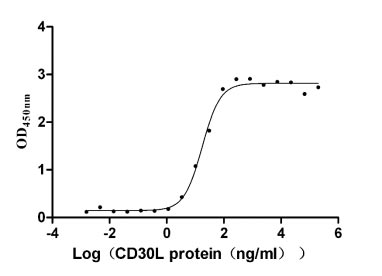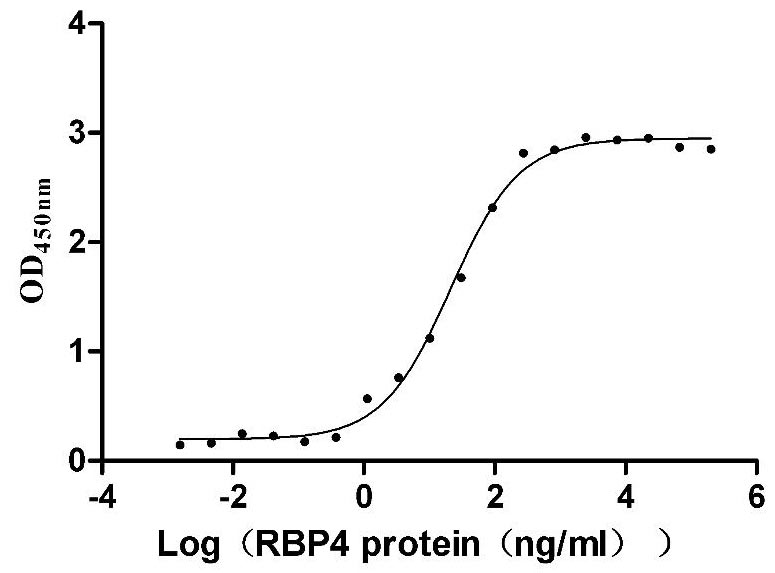Recombinant Mouse Peptide YY (Pyy), partial
-
货号:CSB-YP019128MO
-
规格:
-
来源:Yeast
-
其他:
-
货号:CSB-EP019128MO-B
-
规格:
-
来源:E.coli
-
共轭:Avi-tag Biotinylated
E. coli biotin ligase (BirA) is highly specific in covalently attaching biotin to the 15 amino acid AviTag peptide. This recombinant protein was biotinylated in vivo by AviTag-BirA technology, which method is BriA catalyzes amide linkage between the biotin and the specific lysine of the AviTag.
-
其他:
-
货号:CSB-BP019128MO
-
规格:
-
来源:Baculovirus
-
其他:
-
货号:CSB-MP019128MO
-
规格:
-
来源:Mammalian cell
-
其他:
产品详情
-
纯度:>85% (SDS-PAGE)
-
基因名:
-
Uniprot No.:
-
别名:Pyy; Peptide YY; PYY; Peptide tyrosine tyrosine) [Cleaved into: Peptide YY(3-36; PYY-II)]
-
种属:Mus musculus (Mouse)
-
蛋白长度:Partial
-
表达区域:29-64
-
氨基酸序列YP AKPEAPGEDA SPEELSRYYA SLRHYLNLVT RQRY
-
蛋白标签:Tag type will be determined during the manufacturing process.
The tag type will be determined during production process. If you have specified tag type, please tell us and we will develop the specified tag preferentially. -
产品提供形式:Lyophilized powder
Note: We will preferentially ship the format that we have in stock, however, if you have any special requirement for the format, please remark your requirement when placing the order, we will prepare according to your demand. -
复溶:We recommend that this vial be briefly centrifuged prior to opening to bring the contents to the bottom. Please reconstitute protein in deionized sterile water to a concentration of 0.1-1.0 mg/mL.We recommend to add 5-50% of glycerol (final concentration) and aliquot for long-term storage at -20℃/-80℃. Our default final concentration of glycerol is 50%. Customers could use it as reference.
-
储存条件:Store at -20°C/-80°C upon receipt, aliquoting is necessary for mutiple use. Avoid repeated freeze-thaw cycles.
-
保质期:The shelf life is related to many factors, storage state, buffer ingredients, storage temperature and the stability of the protein itself.
Generally, the shelf life of liquid form is 6 months at -20°C/-80°C. The shelf life of lyophilized form is 12 months at -20°C/-80°C. -
货期:Delivery time may differ from different purchasing way or location, please kindly consult your local distributors for specific delivery time.Note: All of our proteins are default shipped with normal blue ice packs, if you request to ship with dry ice, please communicate with us in advance and extra fees will be charged.
-
注意事项:Repeated freezing and thawing is not recommended. Store working aliquots at 4°C for up to one week.
-
Datasheet :Please contact us to get it.
相关产品
靶点详情
-
功能:This gut peptide inhibits exocrine pancreatic secretion, has a vasoconstrictory action and inhibitis jejunal and colonic mobility.
-
基因功能参考文献:
- Data show that peptide YY (PYY) mRNA levels were ~ 40,000-fold higher in mouse than human islets, suggesting a more important role of locally secreted Pyy in mouse islets. PMID: 29455414
- These results indicate that endogenous PYY has a hypoalgesic effect on somatic thermal and visceral chemical pain. The effect on visceral pain seems to be mediated by peripheral Y2 receptors. PMID: 28106168
- Study suggests that PYY3-36 mediated signalling via Y5 receptors may counteract the anorectic effects that it mediates via the Y2 receptor, consequently lowering bodyweight in the absence of Y5 signalling. PMID: 28485050
- expression of PYY and its NPY receptors on mouse islets and immortalised rodent and human beta-cells was examined. PMID: 27465830
- Angiotensin II stimulates PYY secretion, in turn inhibiting epithelial anion fluxes, thereby reducing net fluid secretion into the colonic lumen. PMID: 27447725
- new information on the cell specific localization of NUCB2/nesfatin-1 in the intestinal mucosa, and a novel function for nesfatin-1 in modulating intestinal CCK and PYY expression and secretion PMID: 26920055
- Data (including data from studies in transgenic mice) suggest neurotensin (Nts), glucagon-like peptide I (GLP-1), and peptide YY (Pyy) are closely co-expressed and co-secreted within enteroendocrine cells in ileum mucosa. PMID: 26469136
- pancreatic islet-derived PYY plays an important role in controlling glucose homeostasis through the modulation of beta-cell mass and function PMID: 26125465
- The patterns of colocalisation of the K cell marker, glucagon-like insulinotropic peptide, and the L cell markers, glucagon like peptide-1 and peptide YY, in enteroendocrine cells of the small intestine and colon of mouse and pig, were investigated. PMID: 25378285
- Glutamine stimulates the co-release of endogenous GLP-1 and PYY from mucosal L-cells resulting in paracrine GLP-1 and Y1 receptor-mediated electrogenic epithelial responses. PMID: 23992397
- Data suggest that an intestinal enteroendocrine cell line (STC-1) secrets PYY constitutively releasing PYY into cell culture media; linoleic acid and conjugated linoleic acid 9,11 are potent PYY secretagogues; most short-chain fatty acids are not. PMID: 22926626
- Suggest that PYY might be one critical mediator of deoxynivalenol-induced anorexia and, ultimately, growth suppression. PMID: 22903826
- gut peptide PYY is critical for the control of bone remodeling. PMID: 22792209
- a lineage of mature enteroendocrine cells have the ability to coexpress members of a group of functionally related peptides: CCK, secretin, GIP, GLP-1, PYY, and neurotensin PMID: 23064014
- PYY reduces food intake while enhancing lipogenic capacity and insulin action, likely contributing to fuel assimilation in the postprandial state. PMID: 22575886
- Data suggest that Pyy expression in hindbrain is regulated by nutritional factors and correlates with circulating PYY and leptin; Pyy decreases in acute starvation, prolonged caloric restriction, and after bariatric surgery (enterogastroanastomosis). PMID: 22761162
- PYY appears to regulate beta cell function and survival via the receptor Y(1/2). PMID: 22562022
- This study demonistrated that PYY has an important role in the regulation of olfactory neuron differentiation. PMID: 22354615
- dietary resistant starch is well tolerated, fermented in the colon, and stimulates colonic expression of proglucagon and PYY mRNA, and adiponectin protein in visceral fat. PMID: 22174009
- PYY(3-36) is also present in murine as well as in human saliva PMID: 22028819
- Gene expressions of ghrelin, PYY, and CCK was increased in the gastrointestinal tract of the hyperphagic intrauterine growth restriction rat offspring. PMID: 21264794
- PYY/PYY(3-36) potently inhibits basal and stress/serotonin/cholinergic-stimulated propulsive colonic motor function in conscious mice, likely via Y(2) receptors PMID: 19892938
- Langerhans cells and a certain BALB/c and A/J mice epidermis-derived dendritic cell line contain mRNA for peptide yy PMID: 12372697
- targeted disruption of the peptide YY gene does not perturb terminal endocrine cell differentiation or the control of food intake and energy homeostasis PMID: 15870288
- Data show that the sustained inhibition of gastric secretion due to tumours producing PYY/enteroglucagon in transgenic mice is associated with an increase in AQP4 expression and a down-regulation of H(+)/K(+)-ATPase in parietal cells. PMID: 15898955
- Reduced expression in gastrin-cholecystokinin knockout mice. PMID: 16002530
- reduced PYY levels may predispose to the development of obesity, particularly with ageing or under conditions of high-fat feeding, as demonstrated in peptie YY-deficient mice. PMID: 16680491
- We generated Pyy null mice, which were selectively resistant to the satiating and weight-reducing effects of protein and developed marked obesity that was reversed by exogenous PYY treatment. PMID: 16950139
- that PYY may be a mediator of islet cell development, as well as a cofactor for growth factor responses, not only during fetal pancreas formation but also during regeneration in adult mice. PMID: 17185798
- Overexpression of PYY by transgenic technique, chronic administration of PYY into normal pregnant mice, or deletion of the PYY Y1 receptor produced neural tube defects. PMID: 17400914
- Diet-induced obese mice had low plasma PYY, which may have caused compensatory up-regulation of PYY and Y2 receptor densities in medulla. PMID: 17615145
- Endogenous PYY plays a critical role in regulating bone mass. In comparison, its role in regulating body weight is minor and is confined to situations of high-fat feeding. PMID: 17920065
- Activation of neurons in the nucleus of the solitary tract following administration of T2R agonists to the GI tract involves CCK(1) and Y(2) receptors located on vagal afferent terminals in the gut wall. PMID: 18003792
- PYY-immunoreactive (ir) cell bodies were localized exclusively to the gigantocellular reticular nucleus (Gi) of the rostral medulla. The highest density of PYY fibers was present within the solitary tract nucleus. PMID: 18022952
- there was no effect of PYY transgenic over expression on basal or fasting-induced food intake PMID: 18164057
显示更多
收起更多
-
亚细胞定位:Secreted.
-
蛋白家族:NPY family
-
数据库链接:
KEGG: mmu:217212
STRING: 10090.ENSMUSP00000017455
UniGene: Mm.46248
Most popular with customers
-
Recombinant Human Tumor necrosis factor receptor superfamily member 8 (TNFRSF8), partial (Active)
Express system: Mammalian cell
Species: Homo sapiens (Human)
-
Recombinant Mouse Transthyretin (Ttr) (Active)
Express system: Mammalian cell
Species: Mus musculus (Mouse)
-
Express system: Mammalian cell
Species: Homo sapiens (Human)
-
Recombinant Human Myosin regulatory light polypeptide 9 (MYL9) (Active)
Express system: Yeast
Species: Homo sapiens (Human)
-
Recombinant Human Oncostatin-M (OSM), partial (Active)
Express system: Mammalian cell
Species: Homo sapiens (Human)
-
Recombinant Macaca fascicularis C-type lectin domain family 4 member C(CLEC4C), partial (Active)
Express system: Mammalian cell
Species: Macaca fascicularis (Crab-eating macaque) (Cynomolgus monkey)
-
Recombinant Human Transmembrane 4 L6 family member 1(TM4SF1)-VLPs (Active)
Express system: Mammalian cell
Species: Homo sapiens (Human)
-




















